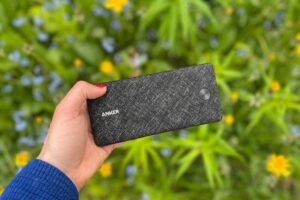Sleeping bags have the unique ability to make or break an outdoor adventure. Having a warm, dry place to sleep at night is the key to enjoying a trip, whether it’s leisurely weekend car camping with the family or a thru-hike on the Pacific Crest Trail.
The ExplorersWeb team has tested over a dozen sleeping bags to help find the right one for you. We tested three-season and summer sleeping bags with temperature ranges from 15° to 30°F, putting them through their paces in the lush mountains of Washington and Peru, the wet tundra above the Arctic Circle in Alaska, and the high mountains of Peru. We looked at both synthetic and down insulation, as well as various shapes of sleeping bags, and took them car camping and backpacking to test their versatility.
In this guide, we recommend our favorite sleeping bags and include helpful advice and answers to frequently asked questions to help you make your own decision.
Editor’s Note: We updated this guide on May 20, 2024 to ensure that our product selection and buying advice were up to date with 2024’s market. We created new categories, including Best Down Sleeping Bag and Best Synthetic Sleeping Bag. The Feathered Friends Egret UL 20 Women’s Sleeping Bag was also chosen as our Best Women’s Sleeping Bag after several years of testing, and our Best Value Sleeping Bag is now the Mountain Hardware Bishop Pass 15 Sleeping Bag.
Our Best Sleeping Bags Picks:
- Best Down Sleeping Bag: REI Co-op Magma 15 Sleeping Bag
- Best Synthetic Sleeping Bag: Nemo Forte 20 Sleeping Bag
- Best Sleeping Bag for Women: Feathered Friends Egret UL 20 Women’s Sleeping Bag
- Most Versatile Sleeping Bag: Big Agnes Lost Ranger 3N1 15 Sleeping Bag
- Best Wearable Sleeping Bag: Sitka Gear Kelvin Aerolite 30 Sleeping Bag
- Best Double Sleeping Bag: Stoic Groundwork Double Sleeping Bag
- Best Sleeping Bag for Car Camping: REI Co-op Siesta Hooded 20 Sleeping Bag
- Best Value Sleeping Bag: Mountain Hardware Bishop Pass 15 Sleeping Bag
Best Down Sleeping Bag:
REI Co-op Magma 15 Sleeping Bag
Features:
- Contains recycled and bluesign® approved materials
- Nine different sizes available, from short-narrow to long-wide
- Contoured hood that shapes and cinches around your face
- Zipper wraps around the front for easier zipping
- Interior stash pocket for small items
- Shaped foot box with room to move your feet
Why we like it: Very warm and size-inclusive
What we don’t like: Not as lofted as other down bags
Shell: 15D recycled ripstop nylon | Insulation: bluesign® approved down | Weight: 2.5 lbs | Packed Volume: 6 to 9L, depending on size | Comfort Temperature Rating: 21°F | Lower Limit Rating: 9°F | Sizes: short (5’4″), medium (5’9″), long (6’4″), as well as narrow and wide
Chelsey’s favorite down sleeping bag is the REI Co-op Magma 15 Sleeping Bag ($429). It’s her go-to sleeping bag when she’s guiding backpacking trips in northern Alaska, where the lower temperature rating compared to other 15° bags keeps her warm when nighttime temperatures dip. Even with its additional insulation, the Magma 15 is lightweight and compresses down into a surprisingly small package, making it a great option for longer trips and heavier backpacks.
It’s also environmentally friendly, with a shell made from recycled nylon and bluesign® approved down fill. The updated Magma 15 comes in a huge range of sizes, from short and narrow to long and wide, so you can pick the perfect size for your body.
Best Synthetic Sleeping Bag:
Nemo Forte 20 Sleeping Bag
Features:
- bluesign® approved DWR shell
- 100% recyclable synthetic insulation
- External draft collar to keep your neck warm
- Integrated pillow pocket
- Designed to be comfortable for side sleepers
- Thermo Gills™ with multistage zippers to increase temperature comfort range
Why we like it: Sustainable, budget-friendly with plenty of features
What we don’t like: Bulky synthetic insulation
Shell: 30D recycled ripstop polyester | Insulation: Synthetic | Weight: 2.5 lbs | Packed Volume: 9L | Comfort Temperature Rating: 30°F | Lower Limit Rating: 20°F | Sizes: regular (6′), long (6’6″)
The Nemo Forte 20 Sleeping Bag ($190) is our favorite synthetic sleeping bag. Nemo upped the sustainable sleeping bag game, prioritizing the use of recycled and reclaimed materials. The Forte shell is bluesign® approved and made of 100% recycled polyester, while the insulation is made from 100% post-consumer recycled content.
Despite using synthetic insulation, the sleeping bag is relatively light. There are also plenty of features, including zippered vents with multistage zippers that you can unzip to cool down on warmer nights. A draft collar tucks in around your neck to keep you warm, or folds down like a blanket to cool you off. An integrated pillow pocket keeps your pillow in your bag while sleeping. We’re also fans of the reasonable price and that the Nemo Forte 20 is available in men’s and women’s sizes.
Best Sleeping Bag for Women:
Feathered Friends Egret UL 20 Women’s Sleeping Bag
Features: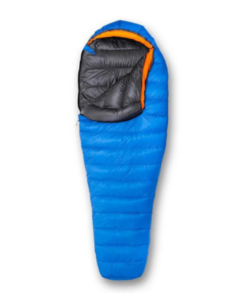
- Designed for women, with tailored fit and extra down at the feet and chest
- Trapezoidal foot box lets your feet rest in a natural position
- Generous draft tube to prevent air from seeping in at the zipper
- Hood opens wide on warmer nights and cinches tight for dropping temps
- Ethically sourced down
Why we like it: High quality, lofted down, lightweight
What we don’t like: Expensive, sizing may not fit everyone
Shell: 10D pertex endurance UL | Insulation: Ethically harvested down | Weight: 1.9 lbs | Packed Volume: 9L | Comfort Temperature Rating: 20°F | Lower Limit Rating: N/A | Sizes: small (5’3″), medium (5’9″)
The Feathered Friends Egret UL 20 Women’s Sleeping Bag ($589) is Chelsey’s pick for the Best Sleeping Bag for Women. She’s been a Feathered Friends convert for six years, and spends upwards of 100 days a year in their bags. The Egret UL 20 is one of her summer bags, and she loves how warm and light it is.
The Egret is tailored for the female form, with more room at the hips and elbows, and extra down in the foot box and chest to keep you warmer. Chelsey particularly likes the large draft tube down the side of the bag, which prevents cold air from sneaking past the zipper. There’s also extra cushioning around the collar to help trap heat in at your neck. All in all, the bag is incredibly toasty, with the highest quality down filling. At 950+ fill power, the down used in the Egret is warmer per square inch than other down options. This means less fill is needed, making the Egret the lightest sleeping bags on our list.
It’s available in small (5’3″) and medium (5’9″) sizes, as well as a 30° temperature rating.
Check Price at Feathered Friends
Most Versatile Sleeping Bag:
Big Agnes Lost Ranger 3N1 15 Sleeping Bag
Features: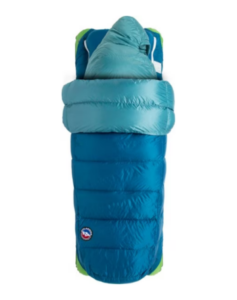
- Three-in-one sleeping bag system
- Inner and outer bags have different temperature ratings
- Attachment system for a sleeping pad
- Great for side sleepers
- PFAS-free water repellent finish
- Also comes in women’s sizes
- Available in 0°, 15°, and 30° (women’s only) temperature ratings
Why we like it: Suitable for a wide range of temperatures, roomy and comfortable for side sleeping
What we don’t like: Sleeping pad attachment system won’t work with every pad
Shell: Polyester | Insulation: Synthetic Primaloft, 35% recycled | Weight: 2.8 lbs | Packed Volume: N/A | Comfort Temperature Rating: 27°F | Lower Limit Rating: 15°F | Sizes: regular (6′), long (6’6″)
While most of us have several sleeping bags with different temperature ratings, the Big Agnes Lost Ranger 3N1 15 Sleeping Bag ($399) is a great way to slim down your sleeping bag quiver. It’s a modular bag system that provides you with one quality system for most adventures. An inner and outer bag combine to create three different bag configurations, depending on the temperature. The inner bag is a mummy bag that mimics Big Agne’s Sidewinder bag, perfect for side sleepers. Used alone, it’s rated to 35°. The outer bag is a classic rectangular bag, and used alone it’s rated to 50°. Used together, the bags are rated to 15°. There’s also a cinching system to attach your pad to your sleeping bag for extra stability.
Both the inner and the outer sleeping bags have 650 fill down insulation, with a PFAS-free water-repellent chemistry. There’s also a women’s version, called the Big Agnes Roxy Ann 3N1 15 Sleeping Bag. It’s available in two sizes, regular (5’5″) and long (6′), and is one of Kirby’s favorite women’s sleeping bags.
Best Wearable Sleeping Bag:
Sitka Gear Kelvin Aerolite 30 Sleeping Bag
Features:
- Lightweight and wearable
- Front two-way zipper
- DWR finish to repel water
- Armholes positioned for functional mobility
- Form-hugging mummy shape
- Foot box can be opened and shortened for walking
Why we like it: Fully featured wearable sleeping bag, perfect for sitting at camp and sleeping
What we don’t like: Expensive, not warm enough for spring or fall in most areas
Shell: 20D polyester | Insulation: 35% recycled synthetic | Weight: 2.4 lbs | Packed Volume: N/A | Comfort Temperature Rating: 30°F | Lower Limit Rating: N/A | Sizes: regular (6′), long (6’6″)
Wearable sleeping bags have armholes and an open bottom, allowing you to keep your arms free and even walk around. Our favorite is the Sitka Gear Kelvin Aerolite 30 Sleeping Bag ($300). Kirby loved how she could sit by the campfire, walk around camp, and even brew her morning coffee, all without ever leaving her sleeping bag. The foot box zips open, and there’s a hidden hook in the middle of the bag to shorten the sleeping bag for walking. There’s also an adjustable hood, a shaped foot box, and every zipper can be unzipped from both inside and outside the bag.
The classic mummy shape of the bag locks in heat while the synthetic down keeps you warm even when wet. The shell is made from durable 20D polyester with a DWR finish to help repel moisture. However, it’s not the warmest bag on the market, and was designed mostly to be used with other Sitka layers to boost the temperature.
Best Double Sleeping Bag:
Stoic Groundwork Double Sleeping Bag
Features:
- Synthetic shell with a water-repellent finish
- Two interior stash pockets for storage
- Soft, cozy interior lining
- Synthetic fill for insulation even in wet conditions
- Unzip into two bags for versatility
Why we like it: You can unzip it into two separate bags
What we don’t like: Only suitable for warm temperatures, comfort rating is only 43°F
Shell: 20D ripstop nylon | Insulation: Synthetic | Weight: 5.6 lbs | Packed Volume: N/A | Comfort Temperature Rating: 43°F | Lower Limit Rating: 20°F| Sizes: one size (6’3″)
The Stoic Groundwork Double Sleeping Bag ($109) is a double-wide sleeping bag with room for two, a perfect excuse to get your partner to snuggle more. There’s a DWR finish to repel water and synthetic insulation retains heat even when wet. Though the bag is light on features, there is an internal stash pocket on each side of the bag, and the double bag unzips into two separate sleeping bags if you’d rather sleep apart.
The Stoic Groundwork Double Sleeping Bag only has a comfort rating of 43°, so reserve it for warmer nights.
Best Sleeping Bag for Car Camping:
REI Co-op Siesta 25 Hooded Sleeping Bag
Features: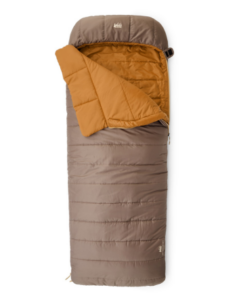
- BlueSign approved shell and fill
- Insulated hood with drawstring
- DWR finish to repel water and stains
- Inner stash pocket
- Two-way main zipper, with a short side zipper to fold down the top
- Plenty of room to sprawl out
- Insulation and shell is 98% recycled
Why we like it: Incredibly roomy, made with recycled materials
What we don’t like: Too bulky for backpacking
Shell: Recycled polyester | Insulation: Synthetic recycled polyester | Weight: 5.4 lbs | Packed Volume: 17.7 L | Comfort Temperature Rating: N/A | Lower Limit Rating: 20°F | Sizes: regular (6′), long (6’6″)
When it comes to the most bang for your buck, the REI Co-op Siesta 20 Hooded Sleeping Bag ($139) shines as a car camping bag. This was one of our favorite unisex bags, with a roomy, rectangular shape that gave us plenty of room to stretch out. The insulated hood adds warmth, while a drawstring helps pull it tight during particularly cold nights. There’s also an interior stash pocket for storing small items like your phone while sleeping.
The Siesta Sleeping bag is also environmentally friendly, with 98% recycled polyester fill and a recycled polyester shell that’s treated with a DWR to help repel stains and moisture. Both the shell and the insulation contain materials that meet bluesign® criteria, and REI is Climate Neutral Certified.
At over five pounds, this sleeping bag is too heavy and bulky for backpacking but is a great budget option for car camping.
Best Value Sleeping Bag:
Mountain Hardware Bishop Pass 15 Sleeping Bag
Features:
- Internal stash pocket for storage
- Shaped draft collar and down face gasket to keep cold air out
- Contoured foot box for natural positioning
- Loops to attach to a sleeping pad
- Glow-in-the-dark zipper
- Men’s and women’s sizes available
Why we like it: Offers warmth and plenty of features at a competitive price
What we don’t like: Heavier than other down backpacking bags
Shell: 20D ripstop nylon | Insulation: Fluorine-free, responsible down | Weight: 2.5 lbs | Packed Volume: 8 L | Comfort Temperature Rating: 26°F | Lower Limit Rating: 15°F | Sizes: regular (6′), long (6’6″)
The Mountain Hardware Bishop Pass 15 Sleeping Bag ($285) is a great do-it-all bag for those who want a sleeping bag they can backpack, camp, and travel with. It offers a surprising amount of warmth, as well as great features like a glow-in-the-dark zipper and a generous draft collar, all at a competitive price compared to other down bags. While it’s not the lightest down bag on the market, Chelsey has used the Bishop Pass backpacking and likes that it compressed down to a relatively small size for a mid-weight bag.
The Bishop Pass 15 is available in men’s and women’s sizes. The women’s version is narrower at the shoulders and wider at the hips, and comes in shorter sizes.
About our testing process

The ExplorersWeb team tested over a dozen sleeping bags to create this guide, at times spending up to a third of the year sleeping in a particular bag to fully vet it. They brought the bags across the United States and the world in order to test them in every temperature and condition possible.
Kirby Kahl started this guide in October 2022. She’s an avid outdoorswoman who spends countless days a year camping and backpacking. She’s learned the hard way that not having the right sleeping bag for the weather is a miserable experience, and prioritizes warmth and comfort. She tested many of the sleeping bags in the guide while car camping and backpacking. Her and her partner shared the Stoic Groundwork Double Sleeping Bag for a few nights and tested the functionality and movement of the Sitka Gear Kelvin Aerolite 30 Sleeping Bag inside their house.
Gear Editor Chelsey Cook took over this guide in May 2024, bringing with her many years and seasons spent camping. As a mountain guide for over six years, Chelsey often spends more time in her sleeping bag than in her bed. Most of her expeditions are at higher latitudes, where even summertime weather can be volatile and cold, and she appreciates a warm sleeping bag that packs down as small as possible. She’s been using the REI Co-op Magma 15 Sleeping Bag and the Feathered Friends Egret UL 20 Women’s Sleeping Bag as her summer sleeping bags in Alaska for years.
Kirby and Chelsey tested the sleeping bags in this guide in a range of different climates and terrains. Kirby tested bags while van camping, car camping, and backpacking throughout Oregon and Washington, in temperatures that ranged from 27°F to 60°F. Chelsey tested sleeping bags on backpacking and packrafting expeditions in Alaska, Utah, Washington, Peru, Tanzania, and Scotland. She slept in a range of conditions, from cold and snowy to hot and dry, at various altitudes. Some nights, temperatures dropped well below 10°F, putting the lower limit temperature ratings to the true test.
In the end, we chose bags for this guide that would fit a range of needs, from car camping to backpacking. We’ve included both synthetic and down bags, as well as high-quality and budget models. There is a range of temperature ratings to cover most three-season needs, and the sleeping bags come with a variety of features. This guide will continue to grow and change as we test new sleeping bags.
Features to look for in sleeping bags

Temperature rating
The temperature rating is the first thing you should look at when choosing the right sleeping bag for you. Many sleeping bags have lab-tested temperature ratings (indicated by “EN” or “ISO” ratings). These tests specify two different temperature ratings. The first is a comfort rating, which is the temperature that a cold sleeper will feel comfortable at in a certain sleeping bag. The second is the lower limit rating. This temperature is always lower than the comfort rating and indicates what outside temperature a warm sleeper might still feel comfortable at.
These ratings are useful when comparing two bags, but keep in mind that real-world comfort may not match lab-tested temperature ratings. Always err on the side of caution, and get a warmer sleeping bag than you think you may need.
If you plan on using your sleeping bag mostly in the summer or are a particularly warm sleeper, a 30° sleeping bag may be enough for you. You can also boost the temperature by wearing extra layers to bed or using a sleeping bag liner. If you want a three-season bag or sleep cold, choose a sleeping bag that is rated closer to 15°. Make sure you look at the comfort rating too; many 15° sleeping bags have a comfort rating closer to 30°. The REI Co-op Magma 15 Sleeping Bag, which has a comfort rating of 21° and a lower temperature rating of 9°, is the warmest-rated bag in this guide.
Insulation type
There are two main types of insulation used in sleeping bags: synthetic insulation and down. Synthetic sleeping bags, like the Nemo Forte 20 Sleeping Bag, are generally filled with polyester and are non-allergenic and more affordable. Synthetic fill continues to insulate when damp and dries fast, but it is heavier and less compressible than down. Synthetic bags are good for wet conditions, or car camping when you don’t have to carry your sleeping bag.
Down sleeping bags, such as the REI Co-op Magma 15 Sleeping Bag, use goose or duck down for insulation, which is warmer than synthetic insulation gram for gram. Down sleeping bags are lightweight, compressible, and durable, making them a good choice for backpacking. While down doesn’t insulate when wet, some brands have water-resistant treatment to protect the down in damp conditions. Most brands also take steps to ethically source down. Look for down that is labeled with RDS (Responsible Down Standard) or TDS (global Traceable Down Standard.) Down also has a fill power rating, which describes its quality. The higher the number, the higher the quality of the down. Look for a fill power of 600 to 800 for the highest quality bags.
Shape
Sleeping bags come in different shapes, including rectangular, semi-rectangular, mummy, and double bag. Rectangular bags have plenty of room to stretch out and can be unzipped and used like a blanket. They’re a good option for car camping, as they tend to be heavier and bulkier. Mummy bags, like the Mountain Hardware Bishop Pass 15 Sleeping Bag, have a snug fit and cinched hood to boost warmth and cut down on weight and packed size, making them a good choice for backpacking. Semi-rectangular bags, like the REI Co-op Siesta 20 Hooded Sleeping Bag, are a happy medium between the two. There are also double bags, such as the Stoic Groundwork Double Sleeping Bag, which are made to fit two people.
Packed size and weight
The packed size and weight of your sleeping bag are particularly important if you are backpacking. Down bags are smaller and lighter than synthetic bags, making them the optimal choice for carrying in a backpack. Look for the lightest and most packable sleeping bag possible, without sacrificing warmth. Most sleeping bags also come with a compression sack, which helps you squish the bag down even further. Just keep in mind that compressing down for long periods can affect the loft of the sleeping bag. Always store your sleeping bag hanging up or in a large cloth sack.
If you’re car camping, or won’t be carrying your sleeping bag, feel free to go with a bulkier, more affordable bag like the REI Co-op Siesta 20 Hooded Sleeping Bag.
Shell material
Most sleeping bags use synthetic fabrics, like nylon and polyester, for their sleeping bag shells. Both of these fabrics repel water and insulate when wet. They come in different denier counts, which measure the diameter of the fabric threads. A higher denier count, like 40D, is generally thought to offer more durability. Some brands also use ripstop nylon or ripstop polyester. These fabrics have extra threads woven into them that help keep small tears from turning into larger ones.
Durable water repellent (DWR) finishes are also frequently used on sleeping bag shells. This increases the water resistance of the material to help keep you dry in wet or humid conditions. PFAS chemicals have historically been used in DWR finishes, though some companies are now moving towards PFAS-free treatments.
Features
Sleeping bags come with a variety of features, designed to make them more comfortable and functional. Inner stash pockets are great for storing phones and other small items, while glow-in-the-dark zippers make getting out easier in the dark. Draft tubes, like the one the Feathered Friends Egret UL 20 Women’s Sleeping Bag has, help keep cold air from seeping in through the zipper, and down collars and cinch hoods keep it from coming in from the top. Other bags, like the Nemo Forte 20 Sleeping Bag, have zippered vents that you can unzip to let warm air out and help regulate your temperature.
Extra features are a great bonus to sleeping bags but don’t splurge on them in favor of a sleeping bag that fits well and keeps you warm. Sleeping bag performance should be your first concern, then extra features.
Frequently asked questions
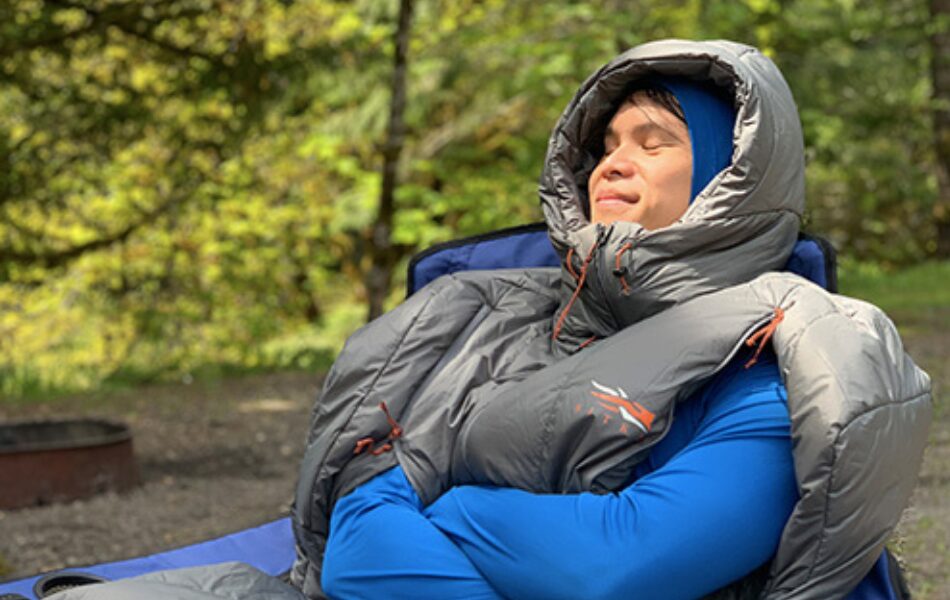
What type of sleeping bag is best?
Rectangular sleeping bags let you stretch out while sleeping but are generally heavier and less packable than other bags. They’re a great option for car camping, where weight and packability don’t matter as much. Mummy bags, which have a slimmer fit, are typically warmer, lighter, and more packable, making them the choice for backpacking trips.
Should I get a down or a synthetic sleeping bag?
Down is by far the warmer and more packable of the two insulation types. If you’re mostly going to be backpacking, or need to pack your sleeping bag frequently, a down bag is probably the best choice for you.
Synthetic bags are heavier and don’t pack down as well as down bags. They are more affordable though, and insulate you even when wet. They’re a great choice for car camping or particularly wet conditions.
What temperature rating should I get for my sleeping bag?
If you’ll mostly be using your sleeping bag in the summer, look for a temperature rating between 10° and 30°. Where you fall in that range depends on whether you’re a cold or a hot sleeper. Chelsey prefers to use a 10° bag for spring, summer, and fall because she is a cold sleeper and is often camping at higher altitudes or in northern environments.
How many years does a sleeping bag last?
A quality down sleeping bag can last over a decade if it’s well cared for. Chelsey has been using the same bag for over five years, and routinely sleeping in it over 100 days a year. When she’s not using it, she makes sure to fluff it out and store it in a large bag in a cool, dry place. She also washes it at least once a season to keep the down clean and fluffy. If dirt and oil are allowed to build up on a bag, it can migrate into the fill and affect its ability to insulate.
Synthetic bags, on the other hand, generally last only a few years. The synthetic filling degrades over time even if well cared for, and gradually loses loft and warmth.

